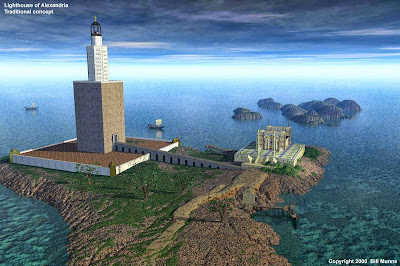The Lighthouse of Alexandria
Lighthouse of Alexandria
The Lighthouse of Alexandria, sometimes called the Pharos of Alexandria (in Ancient Greek, ὁ Φάρος τῆς Ἀλεξανδρείας), was a lofty tower built by the Ptolemaic Kingdom between 280 and 247 BC on the coastal island of Pharos at Alexandria, Egypt for the purpose of guiding sailors into the port.With a height variously estimated at somewhere between 393 and 450 ft (120 and 140 m), it was one of the tallest man-made structures on Earth for many centuries, and was regarded as one of the Seven Wonders of the Ancient World. Badly damaged by three earthquakes between 956 and 1323, it then became an abandoned ruin. It was the third longest surviving ancient wonder (after the Mausoleum at Halicarnassus and the still extant Great Pyramid of Giza) until in 1480 the last of its remnant stones were used to build the Citadel of Qaitbay on the site. In 1994, French archeologists discovered some remains of the lighthouse on the floor of Alexandria's Eastern Harbor.
Lighthouse of Alexandria Origin:
Pharos was a small island just off the coast of the Nile Delta's western edge. In 332 BC when Alexander the Great founded the city of Alexandria on an isthmus opposite to Pharos, he caused the island to be united to the coast by a mole[2] nearly a mile long (1260 m) called the Heptastadion ("seven stadia"—a stadium was a Greek unit of length measuring approximately 180 m). The east side of the mole became the Great Harbor, now an open bay; on the west side laid the port of Eunostos, with its inner basin Kibotos, now vastly enlarged to form the modern harbor. Today's city development lying between the present Grand Square and the modern Ras al-Tiin quarter is built on the silt which gradually widened and obliterated this mole, and Ras al-Tiin represents all that is left of the island of Pharos, the site of the actual lighthouse at its eastern point having been weathered away by the sea.Lighthouse of Alexandria Construction and Destruction:
The lighthouse was constructed in the 3rd century BC. After Alexander the Great died of a fever at age 32, the first Ptolemy (Ptolemy I Soter) announced himself king in 305 BC, and commissioned its construction shortly thereafter. The building was finished during the reign of his son, the second Ptolemy (Ptolemy II Philadelphia). It took 12 years to complete, at a total cost of 800 talents, and served as a prototype for all later lighthouses in the world. The light was produced by a furnace at the top and the tower was said to have been built mostly with solid blocks of limestone. Strabo reported that so stratus had a dedication inscribed in metal letters to the "Savior Gods". Later Pliny the Elder wrote that so stratus was the architect, which is disputed. In the second century AD the satirist Lucian wrote that so stratus inscribed his name under plaster bearing the name of Ptolemy. This was so that when the plaster with Ptolemy's name fell off, So stratus’s name would be visible in the stone.The fullest description of the lighthouse comes from the Arab traveler Abou Haggag Youssef Ibn Mohammed el-Balawi el-Andaloussi, who visited the structure in 1165 AD. His description runs:
The Pharos rises at the end of the island. The building is square, about 8.5 meters (28 ft) each side. The sea surrounds the Pharos except on the east and south sides. This platform measures, along its sides, from the tip, down to the foot of the Pharos walls, 6.5 meters (21 ft) in height. However, on the sea side, it is larger because of the construction and is steeply inclined like the side of a mountain. As the height of the platform increases towards the walls of the Pharos its width narrows until it arrives at the measurements above. ... The doorway to the Pharos is high up. A ramp about 183 meters (600 ft) long used to lead up to it. This ramp rests on a series of curved arches; my companion got beneath one of the arches and stretched out his arms but he was not able to reach the sides. There are 16 of these arches, each gradually getting higher until the doorway is reached, the last one being especially high.
Constructed from large blocks of light-colored stone, the tower was made up of three stages: a lower square section with a central core, a middle octagonal section, and, at the top, a circular section. At its apex was positioned a mirror which reflected sunlight during the day; a fire was lit at night. Extant Roman coins struck by the Alexandrian mint show that a statue of a Triton was positioned on each of the building's four corners. A statue of Poseidon stood atop the tower during the Roman period. The Pharos' masonry blocks were interlocked, sealed together using molten lead, to withstand the pounding of the waves. According to Ibn el-Andaloussi's description, the base tier rested on massive blocks of red granite.







0 comments:
Post a Comment